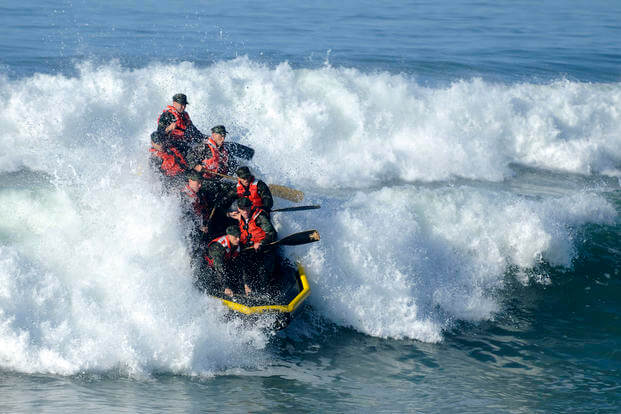People often ask me how I trained for SEAL training before there were movies, books and websites helping people prepare. As a former powerlifting football player, what I thought was in shape for military training was not. I soon learned after arriving at the Naval Academy at age 18 that I was out of military shape.
Here is an email from a young man seeking to become a Navy SEAL but is a college football and powerlifter. He asks, "Right now, my run and swim times are not good. My PT is OK, but I do not have any endurance to do multiple sets of high-rep calisthenics exercises. How do you go from thinking long distance is anything over 100 yards to running and swimming for miles and doing hundreds of reps of push-ups, sit-ups, pull-ups, etc., etc.?"
To truly make this transition, your body can take up to two years to change from a power athlete to an intermediate endurance/strength athlete. SEAL training requires you to be a master of your body weight in obstacle courses, as well as in operational skills. Repeatedly moving your body with power and agility for several sets requires similar movements to many contact sports, but the endurance to continue for miles or hours only comes from running and swimming for intermediate and long distances.
This type of athlete is now known as the tactical athlete, and the military is taking interest in preserving these highly trained "multisport" teams of individuals. With literally millions of dollars of training spent on each individual special operations member, all branches of the military now hire physiology specialists to create programs that will enhance the performance and lengthen the operational lifespan.
The National Strength and Conditioning Association (NSCA), a leader in the science of athletic performance, created the Tactical Strength and Conditioning (TSAC) Program as an answer to this growing trend in human performance. Robb Rogers, the director of the NSCA's Human Performance Center and the TSAC, offered this when asked about transitioning from one type of athlete to another.
"In your case, the football player has a foundation of strength and power and should focus on endurance and muscle stamina training," Rogers said. "There is no need for him to concentrate on his strength development when he is done with football.
"For the average guy, periodization is the key to long-term success. High-rep calisthenics and long-distance running and swimming take (their) toll on the body, as does heavy weightlifting. Both endurance exercises and strength/power exercises should be balanced through the year to maximize gains in strength and endurance."
Here is a basic overview of the physiology that is taking place in your body. On average, humans have about 50% slow-twitch (Type 1) muscle fibers and about 50% fast-twitch fibers (Type 2). Whether it is genetics or adaptation to training routines, Olympic endurance athletes can have up to 80% Type 1 fibers, and Olympic sprinters can have up to 80% Type 2 fibers.
However, there is a division in Type 2 fibers that enable the muscles to have endurance, as well as strength and power. This is Type 2a muscle fiber, which is a happy medium between fast- and slow-twitch muscle. The "traditional Type 2" is actually Type 2b. The jury is out on whether we are capable of changing Type 2b fibers to Type 2a, but I went from a powerlifting football player to SEAL shape in about two years by not lifting weights and focusing on high-rep calisthenics and miles of running and swimming.
So to answer the question, I would drop the weights to make the transition. If that is not possible yet, then simply add the calisthenics (pull-ups, push-ups, sit-ups) on days you work those muscle groups as a compromise. Running 1-2 miles is tough at your weight, so when you are done with football, you need to increase your mileage in swimming and gradually increase running mileage in order to lose weight. You will find running and body-weight exercises are much easier.
Also remember the 10% rule: The "10% rule" applies for increasing volume from week to week. This tends to prevent injury in gung-ho type A personalities that know more is better. With the 10% rule, you only should increase your volume (sets/reps, distance or minutes trained) 10% from week to week and plateau for a week every third or fourth week to allow the body to compensate for the increase.
But I do not think you would be in beginner mode -- perhaps intermediate military PT mode. What you will find is that your muscle strength is large, but your muscle endurance is weak, and that gets better the more reps you do.
Thanks to Rogers for his assistance with this article.
If you have any questions, feel free to email me at stew@stewsmith.com or visit the StewSmith.com Ebook Fitness Store for ideas on training to become a tactical athlete for any branch of service.
Stew Smith is a former Navy SEAL and fitness author certified as a Strength and Conditioning Specialist (CSCS) with the National Strength and Conditioning Association. Visit his Fitness eBook store if you're looking to start a workout program to create a healthy lifestyle. Send your fitness questions to stew@stewsmith.com.
Want to Learn More About Military Life?
Whether you're thinking of joining the military, looking for fitness and basic training tips, or keeping up with military life and benefits, Military.com has you covered. Subscribe to Military.com to have military news, updates and resources delivered directly to your inbox.


















